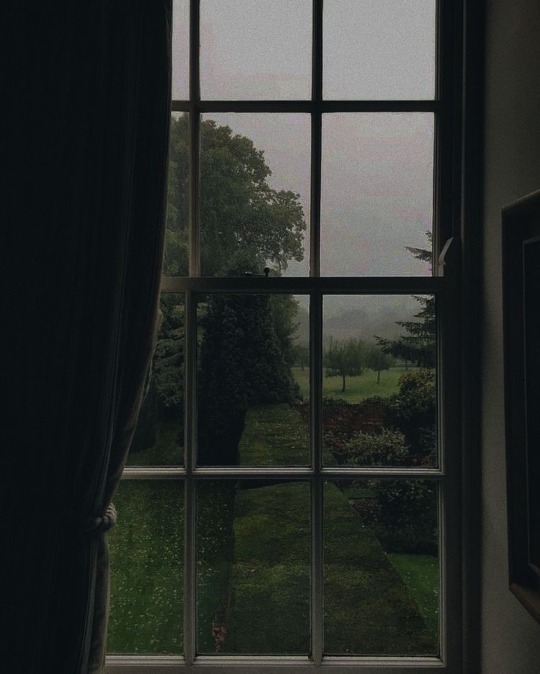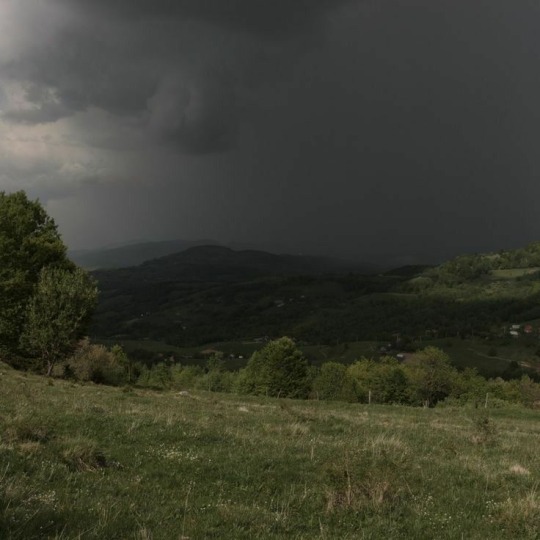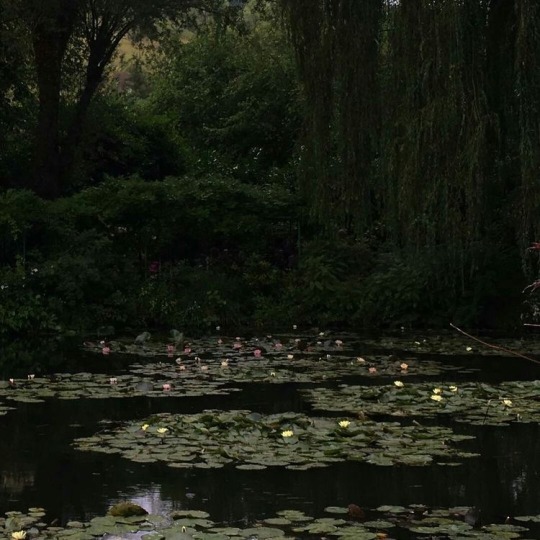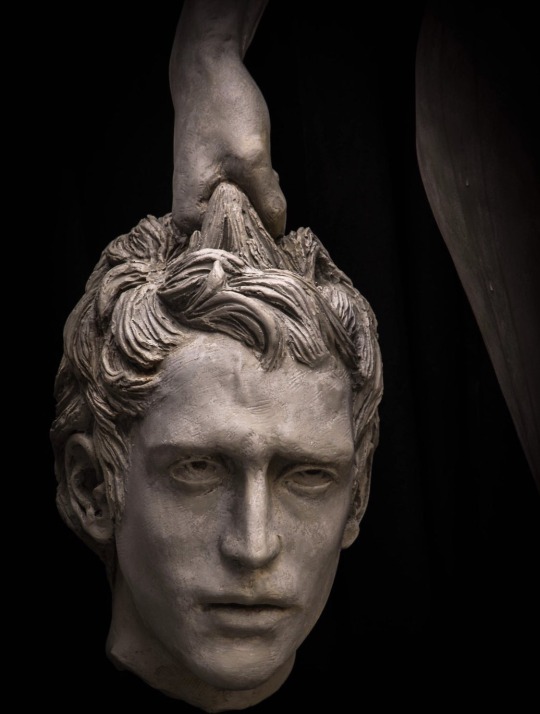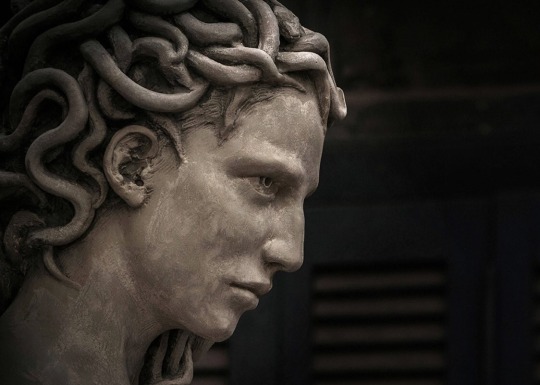Text
It is nanowrimo day two and i am crying.
15 notes
·
View notes
Photo
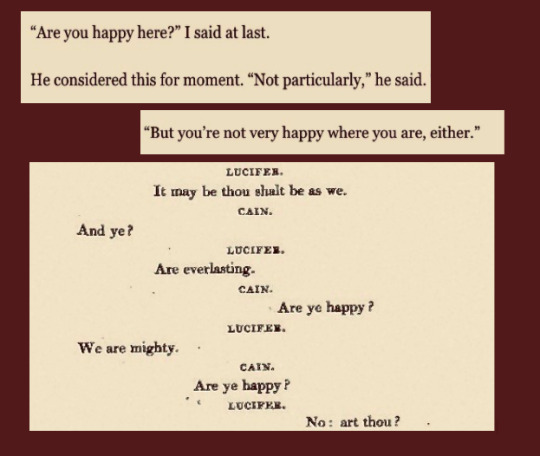
Excerpts from Cain, A Mystery by Lord Byron and The Secret History by Donna Tartt.
11K notes
·
View notes
Text
My favorite John Polidori story
Or my John Polistory, as it were, is the time when he was at lake Geneva with the squad and was sitting in the second floor with Byron.
They could see down below that Mary Shelley was coming up the drive by herself in heavy rain and Byron, knowing that Polidori had a bit of a crush on her and being the sarcastic little shit that he was said that if Polidori was so worried about her, then he should jump off the balcony and walk her inside.
Polidori, who couldn’t recognize a sarcastic quip if it walked up and bit him on the ass, thought that this was a splendid idea and before Byron could say anything, went sailing over the railing of the balcony, landing right in front of Mary.
However, rather than going as smoothly as planned, he slipped on the mud and injured his ankle. This meant that rather than walkinv Mary into the house like a gallant gentleman, she had to support his weight as they limped the last couple meters over the threshold.
438 notes
·
View notes
Note
What are some of your favorite anecdotes about Byron
“If Mary weren’t here I’d throw you overboard, Polidori.”
The time he said he was going to sing but just started screaming.
The time he dined with someone he’d never met before and PURELY FOR THE SPECTACLE claimed he never ate anything other than hard biscuits and soda water. After that, he left to go have a massive meal at some bar.
The time, supposedly, that he overheard someone say he couldn’t hold his liquor so he made sure to out drink everyone present.
The time Polidori asked him what, besides write poetry, could Byron do better than he? To which Byron replied, “Give you a damned good thrashing.”
The fact that he apparently hummed a lot? Mary mentioned it often.
He once told someone to not be poetic.
That he apparently kept a coffin like, in the greeting room. #2edgy4u
@diable-boiteux pointed out that he had staff hide when visitors were around in order to scare them. That makes me laugh.
Of course the whole debacle of, “Well the rule book said NOTHING about not HAVING PET BEARS. Only that I could not have a dog.”
His love for animals in general was so over the top. According to Shelley: “Lord B’s establishment consists…of ten horses, eight enormous dogs, three monkeys, five cats, an eagle, a crow, and a falcon…just met on the grand staircase five peacocks, two guinea hens and an Egyptian Crane.”
1K notes
·
View notes
Text
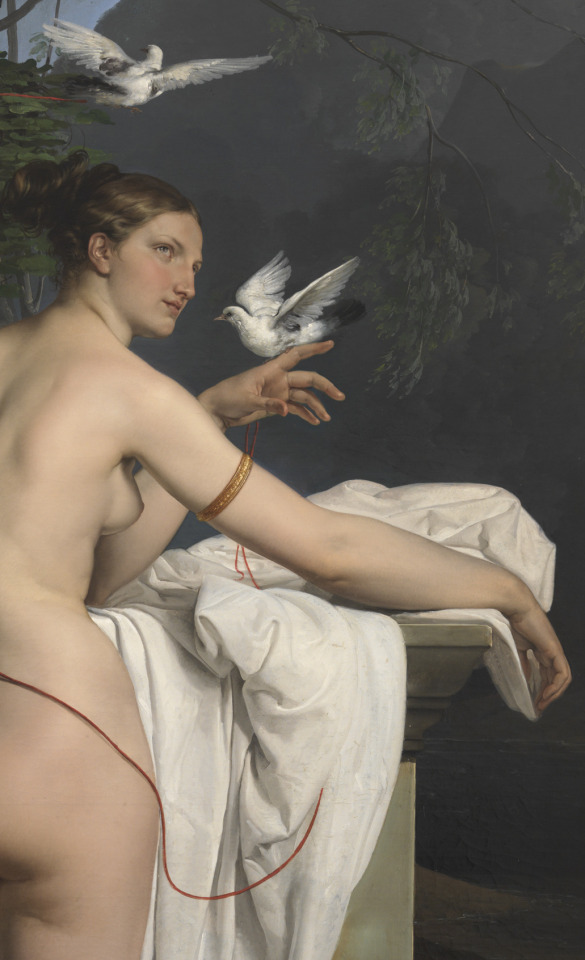
Detail: Venus playing with two doves, by Francesco Hayez, 1830
5K notes
·
View notes
Text

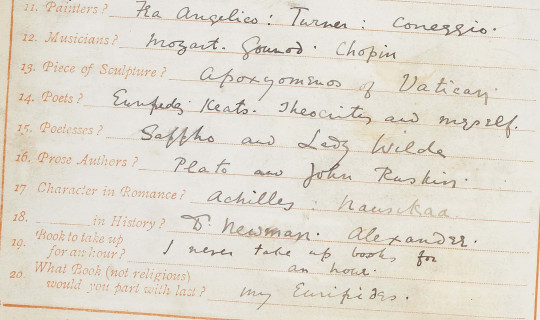
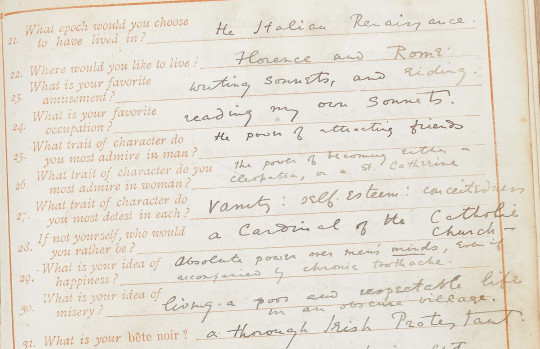

Sotheby's put Oscar Wilde's questionnaire from 1877 out, which means there's a high quality and readable version of this image out.
2K notes
·
View notes
Photo



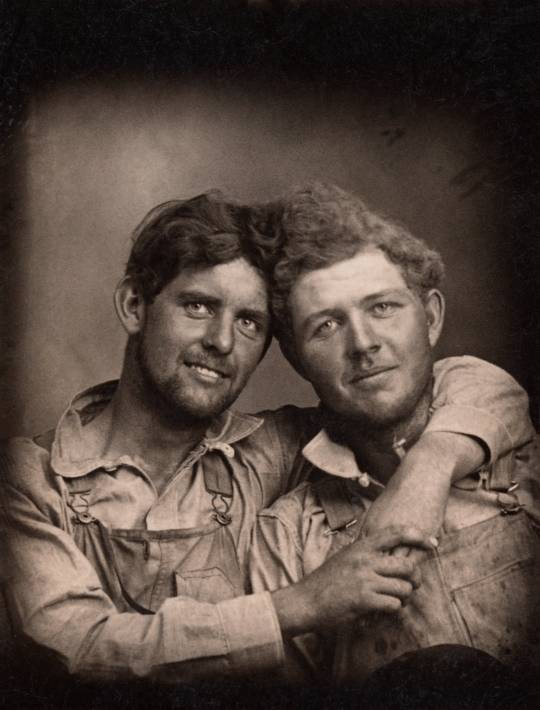

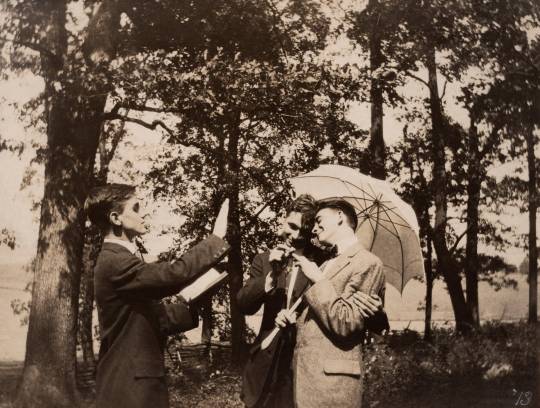

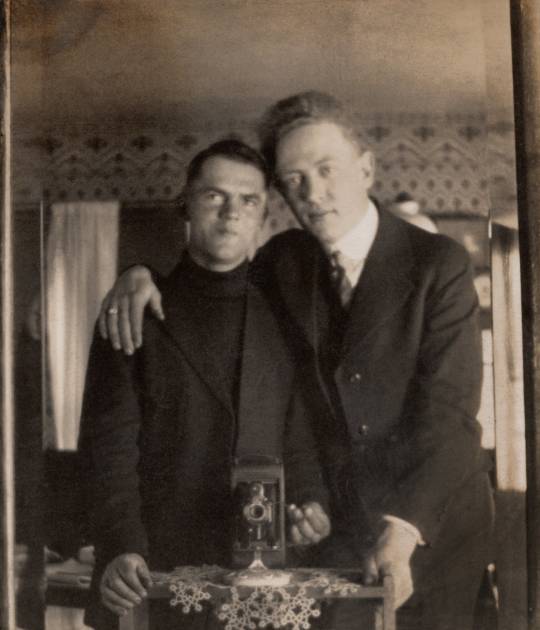


Taken from Loving: A Photographic History of Men in Love 1850s–1950s
138K notes
·
View notes
Photo
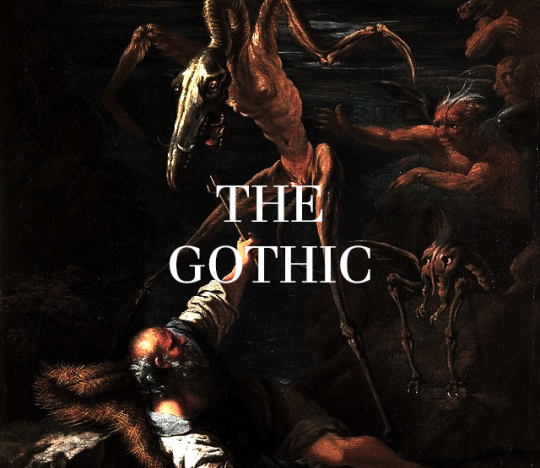
Masterpost of Free Gothic Literature & Theory
Classics
Vathek by William Beckford
Wuthering Heights by Emily Brontë
The Woman in White & The Moonstone by Wilkie Collins
Carmilla by Joseph Sheridan Le Fanu
The Turn of the Screw by Henry James
The Monk by Matthew Lewis
The Phantom of the Opera by Gaston Leroux
Melmoth the Wanderer by Charles Maturin
The Vampyre; a Tale by John Polidori
Collected Works of Edgar Allan Poe
Confessions of an English Opium-Eater by Thomas De Quincey
The Mysteries of Udolpho by Ann Radcliffe
The Strange Case of Dr. Jekyll and Mr. Hyde by Robert Louis Stevenson
Dracula by Bram Stoker
The Castle of Otranto by Horace Walpole
The Picture of Dorian Gray by Oscar Wilde
Frankenstein; Or, The Modern Prometheus by Mary Wollstonecraft Shelley
Short Stories and Poems
An Occurrence at Owl Creek Bridge by Ambrose Bierce
Songs of Innocence & Songs of Experience by William Blake
The Rime of the Ancient Mariner by Samuel Taylor Coleridge
The King in Yellow by Robert W. Chambers
The Legend of Sleepy Hollow by Washington Irving
The Yellow Wallpaper by Charlotte Perkins Gilman
Pre-Gothic
Beowulf
The Divine Comedy by Dante Alighieri
A Journal of the Plague Year by Daniel Defoe
Faust by Johann Wolfgang von Goethe
The Tragical History of Doctor Faustus by Christopher Marlowe
Paradise Lost by John Milton
Macbeth by William Shakespeare
Oedipus, King of Thebes by Sophocles
The Duchess of Malfi by John Webster
Gothic-Adjacent
Northanger Abbey by Jane Austen
The Wendigo by Algernon Blackwood
Jane Eyre & Villette by Charlotte Brontë
Lyrical Ballads, With a Few Other Poems by Coleridge and Wordsworth
The Mystery of Edwin Drood by Charles Dickens
The Idiot & Demons (The Possessed) by Fyodor Dostoyevsky
The Man in the Iron Mask by Alexandre Dumas
Moby-Dick by Herman Melville
The Island of Doctor Moreau by H. G. Wells
Historical Theory and Background
The French Revolution of 1789 by John S. C. Abbott
Shakespearean Tragedy: Lectures on Hamlet, Othello, King Lear, Macbeth by A. C. Bradley
The Tale of Terror: A Study of the Gothic Romance by Edith Birkhead
On Heroes, Hero-Worship, and the Heroic in History by Thomas Carlyle
Demonology and Devil-Lore by Moncure Daniel Conway
Ancient Pagan and Modern Christian Symbolism by Inman and Newton
On Liberty by John Stuart Mill
The Social Contract & Discourses by Jean-Jacques Rousseau
Feminism in Greek Literature from Homer to Aristotle by Frederick Wright
Academic Theory
Introduction: Replicating Bodies in Nineteenth-Century Science and Culture by Will Abberley
Viewpoint: Transatlantic Scholarship on Victorian Literature and Culture by Isobel Armstrong
Theories of Space and the Nineteenth-Century Novel by Isobel Armstrong
The Higher Spaces of the Late Nineteenth-Century Novel by Mark Blacklock
The Shipwrecked salvation, metaphor of penance in the Catalan gothic by Marta Nuet Blanch
Marching towards Destruction: the Crowd in Urban Gothic by Christophe Chambost
Women, Power and Conflict: The Gothic heroine and “Chocolate-box Gothic” by Avril Horner
Psychos’ Haunting Memories: A(n) (Un)common Literary Heritage by Maria Antónia Lima
‘Thrilled with Chilly Horror’: A Formulaic Pattern in Gothic Fiction by Aguirre Manuel
The terms “Gothic” and “Neogothic” in the context of Literary History by O. V. Razumovskaja
The Female Vampires and the Uncanny Childhood by Gabriele Scalessa
Curating Gothic Nightmares by Heather Tilley
Elizabeth Bowen, Modernism, and the Spectre of Anglo-Ireland by James F. Wurtz
Hesitation, Projection and Desire: The Fictionalizing ‘as if…’ in Dostoevskii’s Early Works by Sarah J. Young
Intermediality and polymorphism of narratives in the Gothic tradition by Ihina Zoia
44K notes
·
View notes
Photo






🖤 beauty is terror - he/xem 🖤
my dark academia lookbook ! i had a lot of fun putting this together. my favourites are probably the last two ^^ (ps i also have these on my instagram @/adrientheodorepercival if u wanna check me out there)
2K notes
·
View notes
Text
So... Hamlet is a Libra????
#shakespeare#dark academia#hamlet#light academia#funny#meme#dark acadamia aesthetic#literature#literary
5 notes
·
View notes
Note
Do you have any tips for short story writing? I'm currently writing one right now but not sure how to bring my story to a close as well as incorporate enough detail without it being too much. Very appreciative of you and your channel!😊
I do! I searched through my blog for some posts I’ve already made on short stories, so I’m just going to post them here as a comprehensive short story writing thing.
MY SHORT STORY WRITING PROCESS
My process for stories looks like this:
First I draft, which is not always linear. Meaning if I’m halfway through and I realize I needed a scene earlier on, I jump back and write it. Mostly I do write in order, though. I also go back and edit a lot as I’m drafting.
Once the first draft is done I attend to any large plot issues I see. The story has probably been edited several times by this point since I edit as a go, but we’ll call it one draft even though it’s more like three. Plot issues sometimes involve adding/removing scenes, but this also involves going back to scenes that are severely under written since I am an underwriter.
Then, I usually do two drafts on the computer looking at line level stuff. Basically just reading through the story and cleaning it up.
After that I start printing hard copies. This is also for line edits. My focus is everything prose here (if I notice more plot/character issues I’ll fix them though). Grammar is usually fine except for the odd typo or comma splice (my first drafts are generally grammatically pretty clean). Mostly I’m focusing on editing for economy, meaning cutting every word that’s not adding something and arranging sentences to be as economical as possible. And, I’m focusing on strengthening the prose which involves: cutting -ing verbs, cutting -ly adverbs, using the strongest possible verb/noun/word, removing cliches and familiar phrases, fixing monotonous sentence rhythm, removing repetitive word choice, fixing repetitive noun + verb constructions, removing ‘to be’ verbs, removing filters, removing passive voice, fixing convoluted phrases, enhancing patterns or making them more subtle if too obvious, cutting weasel words, removing unnecessary telling, varying vocabulary and enhancing diction, adding specific details and removing vague ones. And more! Also on those printed copies I have a strong focus on expanding description beats (or dialogue beats) that were underwritten in the original draft, as well as trying to make every image or analogy original and interesting. Basically, I’m trying to make the prose as clean and interesting as it can be.
I generally do that 5-7 times. Each draft has two parts. First editing on the hard copy, then going back into the document. I usually edit on the hard copy in the evening, and then the next morning go into the document. Each half of the process takes over an hour. Sometimes two for earlier drafts, but the time gets shorter with each one.
Then it gets handed in to my workshop, and it’s generally on draft 7-9.
After the workshop I do all my plot edits first. Then, I go back into the line level, except this time referencing hard copy edits from my prof and peers. I’ll have around 13 hard copies with edits, although some people in my workshop don’t do many line edits so there’re usually only 5ish with a lot written on them.
Post workshop is going to be another 7 or so drafts.
After I get my final grade from my prof I’ll do another few drafts based on her final comments. I think for Melting Point I did like four drafts after getting my final grade, but they were quick drafts with very few line edits. Just adding some new stuff and final polishing.
So in total a short story is looking like 15+ drafts, probably over 20
HOW TO GET STARTED WITH SHORT STORIES
I think one of the biggest misconceptions from people who don’t write short stories (including myself before I started writing short stories) is that the medium is restricting.
Yes, you have less words to tell a story. But, it’s not restricting. The short story form is so free. There is no one way a short story has to be. There are stories that only capture a single moment in time, there are short stories that span decades. In fact, in the short form, you can do cool, experimental, meta stuff that novels don’t accommodate as well.
It is very hard to get started in short stories when you’re used to writing novels, but I think the best thing to do is read some short stories, and jump into writing one. Once you’ve had more experience writing short stories, it’ll get easier and easier to determine what ideas function well in the short form.
I always like to make it clear that I never wrote short stories until I had to for school. I had a time restraint, and so naturally I had to get the thing done. I had to force myself to keep the ideas small. I’d suggest you impose similar rules on yourself. Refuse to go over a certain word limit, and make yourself contain the idea. Once you’ve done it once, it’ll be easier each time.
There are lots of ways to get started with a story. You can start with a character, determine their goal and subtextual goal, their want and need, and work from there. You can pick a setting that feels vivid to you and drop some characters in. You can start with a concept you want to explore. I like to use photographs as inspiration as a sort of prompt, building a story around the feeling of the image.
With short stories, sometimes it can be fun to just wing it. I am a plotter with novels, but often with short stories I don’t know where it’s going at first. I’ll get an idea for an image and just start writing. It feels like less of a risk because short stories are much easier to revise than novels. A lot of my short stories start with the first line. I write a few pages to feel it out, and the story usually clears up around the 3-7 page mark.
My biggest advice would be to just start. You don’t even have to know where it’s going. The more short stories you write, the easier they’ll be and the more adventurous you’ll realize you can be with the form.
HOW TO EDIT A SHORT STORY
When it comes to short stories, first I would go through this checklist:1. Is the inciting incident clear and not too late in the story?2. Is the climax clear and not out of the protagonist’s hands?3. Are all the events in the story causally related?4. Are all flashbacks needed, and described rather than explained in an expository way when they necessitate in-depth description?5. Have you physically described your main character? Other characters?6. Does your protagonist have an external and subtextual goal?7. Does your protagonist face internal, interpersonal, and societal conflict?8. Does the protagonist surprise us? That is, act in a way that reveals new complexities and facets of their personality? They are not one-dimensional.
Once you’ve dealt with all of those, I would recommend printing your story and doing line edits. When I’m revising a short story I print the story every evening, and read it through and make notes all over. A lot of notes. My most common notes are ‘sw’ which means ‘stronger word’ or ‘add one/two sentences/clauses to image’ which is basically just me wanting to carry an image more fully. But, I look for tons of things. Then, the next day I go through and apply all my edits. I repeat that for usually around seven drafts.
But, I would also recommend finding some betas of CPs to make sure you get outside feedback.
SHORT STORY TIPS
1. The economy and the skill of the language is key in a short story. I wouldn’t read a boring novel just because it had gorgeous writing, but I honestly would read a boring short story if the writing was amazing. Stay focused and be as economical as possible.
2. Cut the ‘connective tissue.’ All events need to have clear causal relation, but you can trim all the stuff around the edges.
3. Don’t be afraid to experiment. You don’t get this luxury as much in a novel. A heavily experimental voice or form might not be able to sustain itself for 80 000 words, but it can for 5000. If it benefits the story, don’t be scared to try something like second person or a really unique voice. It could make the story.
4. Every character should have an external goal (what is wanted) and a subtextual goal (why the goal is wanted). This applies to novels as well, but in a short story there isn’t time to ponder the goal, change the goal, discover the goal. Establish the goal and explore it, and make sure it’s clear.
5. Make sure your inciting incident isn’t too late. This has been the downfall of so many short stories in my workshop (including mine). Place it as early as possible.
6. Make sure the ending involves a character’s choice, and is not deus ex machina. This applies to novels, but I think it happens more in short stories. With so little time it’s easy to make the ending a coincidence or something outside the protagonist’s hands. Avoid this at all costs.
7. Compress the timeline as much as possible. Why have events be spaced three months apart if they could happen on the same day? It’ll make the story feel tighter and more cohesive, as well as reduce confusion.
8. Cohesion. Every aspect of the story should feel as if it is a cohesive part of the story.
9. Be careful about withholding information. I made this mistake in my first story, because I was used to writing novels where the rate of reveal is slower. You’ll run into mad clarity issues if you’re revealing important details late in the story. Be clear as early as possible.
109 notes
·
View notes
